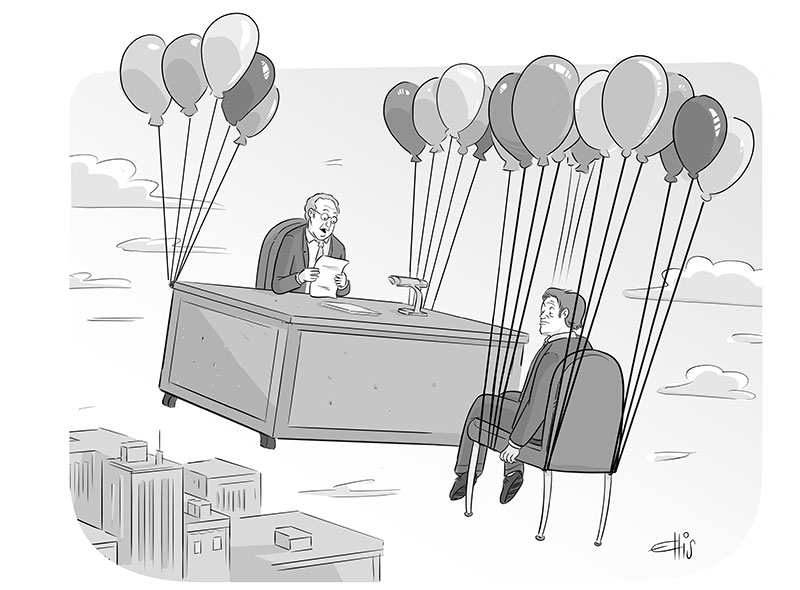 Like many of you, I have lost The New Yorker’s Cartoon Caption Contest hundreds of times. But I’ve won it more than anyone else, so Bob Mankoff thought I might have something useful to say about the contest he recently started running on this website.
Like many of you, I have lost The New Yorker’s Cartoon Caption Contest hundreds of times. But I’ve won it more than anyone else, so Bob Mankoff thought I might have something useful to say about the contest he recently started running on this website.
Each week I will write about the most recently concluded contest, delving into my process for thinking of captions, and then highlighting some of your entries (those I particularly liked, and maybe a few I hated) to find out what works, what doesn’t, and why. I won’t look at your entries until after coming up with my own captions.
I am not allowed to enter the CartoonStock contest—I’ve been banned—and I have nothing to do with selecting each week’s winning caption and two finalists. That’s someone else’s job. I’m here solely to provide some insight that may help you win The New Yorker’s caption contest (for those who want to brag about getting published in the magazine) or this latest version (for those who want $100).
 The contest that ended last week featured Ellis Rosen’s drawing of an airborne job interview. The older man—the one conducting the interview—is speaking, and therefore delivering the line that must address both the interview process and flying through the air while suspended from balloons.
The contest that ended last week featured Ellis Rosen’s drawing of an airborne job interview. The older man—the one conducting the interview—is speaking, and therefore delivering the line that must address both the interview process and flying through the air while suspended from balloons.
The drawing initially reminded me of the animated movie, “Up,” so my first and not very good idea was, “Why do you want to work for Pixar?”
I then thought about typical interview questions that would take on atypically interesting meanings in the context of the drawing, such as “Tell me how you deal with work-related challenges,” and “Do you have any questions for me?”
I next tried to connect the office setting to floating through the air with, “Some people are distracted by the open office plan.”
I then tried to think of business expressions that could be connected to the balloons. “Put a pin in it,” a phrase used by management types to mean, “let’s come back to that later,” led to, “Hold that thought, but don’t put a pin in anything.”
Finally, I focused on the words “job” and “interview,” which led to “It’s a dream job, but only because you’re dreaming,” and, “Can you land the interview?” This last caption is, like the standard interview questions above, a common line that takes on an entirely new meaning in the context of the drawing.
Now, let’s take a look at some of your entries. There were almost 3,000, and many focused on the word “inflation,” which cleverly and concisely addresses both business concerns and balloons. My favorite such caption, however, was, “We worry more about deflation.” It’s short and reconciles the disparate frames of reference—two essential qualities of a successful caption—but adds another interesting element (a fear of falling) missing from similar entries.
Many of you referenced “the cloud,” a reference I would have dismissed as too obvious had I been smart enough to think of it myself. Many of these entries, however, were too long or buried the punchline (“the cloud”) in the middle of the caption. That’s why I liked, “We’re moving to the cloud.”
Although I assumed the drawing depicted part of a hiring process, some of you saw it as just the opposite and came up with several good captions, including, “We’re letting you go.”
Like I did, many of you thought of typical interview questions (or clever variations on these questions) that took on different meanings in the context of the drawing. The best of these included, “Tell me about a time you were in a stressful situation” (similar to but better than my own “work-related challenges” caption), “Where do you see yourself in five minutes?” and “Any problems finding us?”
One of you submitted, “So you’re trying to land a desk job?” That’s similar to my “land the interview” caption but better because people talk more about landing a job than landing an interview.
Several captions referenced traveling for work, but the best of these addressed the fact that anyone tethered to balloons has little control over his destination. My favorite: “This job involves travel to who knows where.”
Some of the best captions not only make sense of a bizarre drawing but truly surprise the reader. That’s why I love, “Spiders. You?” Although this entry loses points for ignoring the fact that the characters are floating high in the air because of balloons, it adds another completely unexpected but fitting angle (a discussion of common phobias, including the applicant’s fear of heights). And it accomplishes this goal with just two words.
That’s all for this week. I hope it helps.
Lawrence Wood has won The New Yorker’s Cartoon Caption Contest a record-setting seven times and been a finalist four other times. He has collaborated with New Yorker cartoonists Peter Kuper, Lila Ash, Felipe Galindo Gomez, and Harry Bliss (until Bliss tossed him aside, as anyone would, to collaborate with Steve Martin). Nine of his collaborations have appeared in The New Yorker, and one is included in The New Yorker Encyclopedia of Cartoons.

